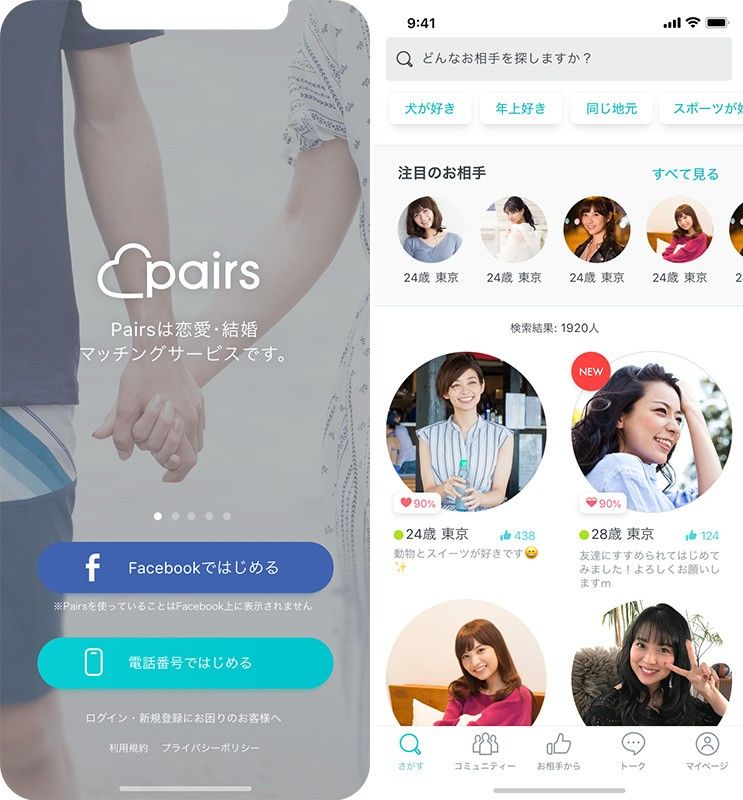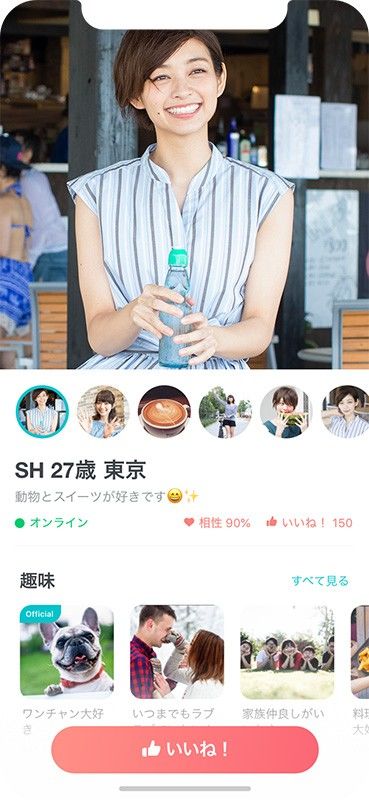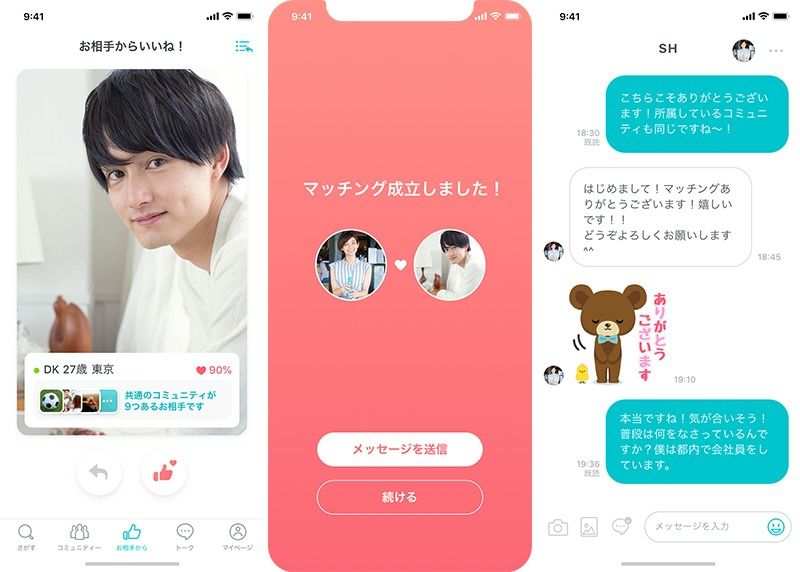
Matchmaking Apps Make Finding a Spouse a Breeze
Society- English
- 日本語
- 简体字
- 繁體字
- Français
- Español
- العربية
- Русский
Exhaustive Vetting to Prevent Illicit Access
When people learn that looking for a future wife or husband online is now a common choice, many express surprise—or even concern about the safety of this method. However, data on numbers of registered users confirms that the bar to online matchmaking has been lowered significantly in recent years. Matchmaking app Pairs, which commenced service in 2012, is the largest in the industry, with a total of 8 million users having signed up to date. Numerous similar apps are available for download, including competitors like Omiai and With.
 The interface for matchmaking app Pairs. After logging in, users see a menu of prospective matches on their devices. (Photo courtesy Eureka)
The interface for matchmaking app Pairs. After logging in, users see a menu of prospective matches on their devices. (Photo courtesy Eureka)
The first thing the user notices is how different Pairs is from conventional online dating sites. Despite the 2003 enactment of a law for the prevention of child prostitution and other criminal activity in an attempt to clamp down on the misuse of dating sites, large numbers of children and teenagers continued to fall prey to blackmail, robbery and rape perpetrated by people they had met online, leading to a further tightening of the regulations in 2008.
Tayama Keiko, a public relations officer at Eureka, the company that developed and operates the Pairs platform, explains how it differs from the typical image of online dating:
“When you use what are generally called ‘online dating sites,’ the more you use the service, the more you pay. You might be charged for every message you send, for example. These sites are also full of fake profiles created by the operator of the platform to make the menu of options seem more attractive. Pairs, on the other hand, generally doesn’t charge women to use the service, and charges male users a flat fee that goes as low as ¥3,480 per month. There are also no fake profiles on Pairs. It’s a service for those looking for a serious relationship or a spouse.”
In the United States, according to the online connection platform operator Match Group, 44% of single people aged 18 years and over use matchmaking services. The numbers go even higher elsewhere, reaching 52% in Britain, 58% in France, and 60% in Germany.
“While the checkered past of online dating services in Japan has made the Japanese late adopters,” says Tayama, “over 150,000 Pairs users to date have told us that they found their partner or spouse using the app.”
On Pairs, before you can exchange messages with matches you need to submit identification verifying your age. Eureka has a 40-strong on-site team of operators working around the clock to vet applications, patrol the site, and respond to inquiries. The app also filters out inappropriate images and messages with various approaches, including deployment of an advance-detection system that uses artificial intelligence and machine learning to analyze activity logs.
Finding the Best Match in a Big Pool
In addition to basic information, including age, location, height, job, and salary, Pairs profiles include a range of other particulars, such as whether the user wants to get married or have children, willingness to perform housework and parental duties, and preferences on who should pay for the first date. While users can leave these fields blank, they play a valuable role in painting a fuller picture of the prospective partner, illuminating differences in views that are difficult to bring up directly but that can have a large impact as the couple progresses from the first date to a relationship.
 The member profile page shows uploaded personal photos along with information on interests and hobbies. (Photo courtesy Eureka)
The member profile page shows uploaded personal photos along with information on interests and hobbies. (Photo courtesy Eureka)
Pairs also has over registered 100,000 communities for users to meet people with similar interests. Communities can be created by users themselves as well as by the service provider. They range from the orthodox, such as “overseas travel lovers” and “music lovers,” to groups that reveal users’ lifestyles and personalities, such as “Into smoking and drinking,” “People who need some ‘me time,’” and “Messages welcome after midnight.”
“When a user ‘likes’ a member of the opposite sex and is ‘liked’ back, the couple forms a match and become able message one another,” Tayama explains. “When we interview married couples who met on Pairs, we find that it was often the woman who sent the first ‘like.’” The company’s goal, she explains, is to give users the support they need to enable both women and men to choose the lives they want.
 Once you have “liked” someone and been “liked” back, you can exchange messages. (Photo courtesy Eureka)
Once you have “liked” someone and been “liked” back, you can exchange messages. (Photo courtesy Eureka)
A Chance to Meet the Ideal Mate
So what do users think of the app? We talked to two married couples who met on Pairs.
A and B met each other on the app in June 2014, began dating in July of the same year, and married in July 2015. A, the husband, is currently 31, while B, his wife, is eight years his senior at 39. The couple are parents to an 18-month old. A, who says that he joined Pairs “for a laugh” after seeing an online ad, says that he exchanged messages with about 20 women, leading to dates with at least five.
A says that after “liking” a woman, he would generally receive a reply within 24 hours. They would exchange a handful of messages on the Pairs app before switching to Line; usually, around three days later they would arrange to meet. A has heard of people arranging a date with one person in the morning and another in the afternoon, but thinks that most users would not be put off by learning that their date was meeting with others, because both parties are “in the same boat.”
“Working at an all-female workplace, I had no prospect of meeting anyone through work,” says B. “When I told my friends that I wanted to find a man who was kind, sincere, masculine, and active, as well as liking music, playing an instrument, being into travel, and speaking English, they told me I was dreaming. Just when I had started to think that I would never find a husband, a coworker of mine married a man she met on the Internet. That’s what prompted me to sign up for Omiai and Pairs.”
B met with a total of three men via the two dating services. When asked about bad experiences, she talked about men who profiles simply said “unmarried” but whose past blog posts revealed they were divorced—an issue that is, of course, not unique to dating apps.
After B strongly recommended Pairs to her friends on the basis of her own experience of finding a husband, one friend also found a husband on Pairs, while another friend is now engaged to be married. She says that the only issue for her is that she does not feel comfortable telling her parents how she met her husband, so evades questions on the topic.
If You Don’t “Click”, Simply Move on
Another male app user, the 31-year-old C, says that although his workplace—a prime spot to meet mates—skewed heavily female, that was actually why he chose to search for a partner online.
“Relationships with coworkers are a hassle. I wanted to meet a partner outside work. I went to both officially organized and private mixer events, but found that the number of women I could meet at a given event was limited. I also felt a bit inhibited if the event was being organized by a friend. Pairs, on the other hand, has a large pool of members and lots of communities, so you can narrow down your options efficiently. Communities are useful not just for finding people with the same interests, but also for eliminating a woman if she is a member of a community such as “Love tall men.”
C says that he gave his Line ID to around 30 or 40 women, in the end meeting between 15 and 20. Of these, he dated three, one of whom is now his wife, the 30-year-old D—who, in contrast to her husband, says that it would have been impossible to meet a mariage partner at her workplace.
“After about a year of looking for a future husband through mixer events to no avail, I decided that I didn’t want to waste time. I wanted to get married while I was still in my twenties. Initially, the idea of dating services was intimidating, but some of my friends use them, so I joined up with the idea that it was purely a tool to find a partner.”
D joined Pairs in January 2017. Before meeting C, she went on a date with one other man, but stopped contacting him as soon as he told her he had no plans to settle down. D subsequently went on her first date with C in February, and on their third date the two began their relationship. D was on Pairs for a total of around two months.
“I took the swift and intensive approach. I made the first move by ‘liking’ his profile. While I suspected I would get a lot of likes if I uploaded a flattering photo of myself, I didn’t want to meet a guy only to be told that I didn’t look like my photo, and I also didn’t want to have to choose from a large number of ‘likes.’ At the same time, I felt that men who immediately asked to meet me were risky, so I didn’t meet any of them. I spent about a month corresponding with my husband to see how sincere he was.”
While D didn’t want to waste time on formalities, she did wait until she was satisfied that C ticked the boxes in areas that mattered. In April, about a month after beginning their relationship, the couple moved in together with a view to marriage eventually. D kept things fuzzy with her parents, simply telling them that she met her partner when “spouse-hunting.” C proposed in July and the two were married in January 2018. Like A and B, C and D took a fast track to marriage, eventually marrying around a year after they first met. Because this was a clear objective for both parties, the progression to the wedding was swift and smooth.
“The party atmosphere at mixer events is actually a turnoff for me, so if I had met my husband at a mixer I probably wouldn’t have been interested,” says D. “Pairs is good in that it allows you to tell the other person about yourself, one-on-one. It’s also nice to be able to simply ignore guys you don’t click with. I mean, I wouldn’t feel rejected if a guy suddenly stopped replying to my messages either: it’s not like I know him. I would just think, ‘onward and upward.’”
A man and woman who would otherwise never have met become a couple. For them, matchmaking apps are like a modern-day Cupid. However, these services are not for everyone. Some who try Pairs feel it just doesn’t click and opt for another service or sign up with a real-world spouse introduction agency instead. In order to benefit from this Cupid in app form, you need to be comfortable online, to have the organizational and communication skills to correspond with a large number of people concurrently, and to show the desire to find your future husband or wife on your own.
(Originally published in Japanese on October 18, 2018. Reporting and text by Anraku Yukiko of Power News. Banner photo © Fast & Slow/Pixta.)